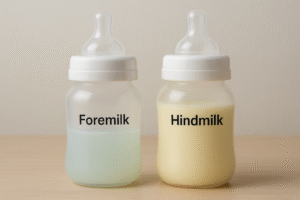If you’ve ever used breast milk test strips and noticed the color changing after just a couple of minutes, you’re not alone. Many new moms wonder whether that fast color shift is a sign of something wrong with their milk.
In this guide, we’ll explain what the color change means, how to read the test accurately, and when you should (and shouldn’t) worry — based on U.S. safety standards and CDC recommendations.
How Breast Milk Test Strips Work
Breast milk test strips are designed to detect spoilage or bacterial growth by identifying changes in the milk’s pH level.
- Fresh milk usually has a neutral pH (around 7).
- As milk starts to spoil, its acidity rises, causing the test strip color to change.
Each brand uses different color indicators, but most shift between blue, green, or yellow as a response to pH change.
Why the Color Changes After Two Minutes

That rapid change (within 1–2 minutes) doesn’t automatically mean your milk has gone bad. It simply reflects a chemical reaction between the milk and the strip’s reagent.
However:
- If the color continues to darken after 2 minutes, it can indicate overexposure or milk that’s been sitting out too long.
- Always follow your test strip’s instructions — readings taken beyond 2 minutes are often inaccurate.
Tip: Read results right at the 1–2 minute mark for the best accuracy.
Common Causes of Rapid Color Shift
- Temperature changes — Warm milk reacts faster than chilled milk.
- Old or thawed milk — Longer storage increases acidity, which speeds up color reaction.
- High lipase activity — Safe, but may slightly alter strip readings due to fat breakdown.
👉 High lipase activity can sometimes cause milk to test slightly acidic early, but this is safe. Always confirm freshness by checking smell and texture, not just the 2-minute strip color. - Improper storage — Leaving milk at room temperature for over 2 hours increases pH changes and test inaccuracies.
For proper storage times, see How Long Does Breast Milk Last in the Fridge?
What To Do If Milk Fails the Test

If your strip shows signs of spoilage:
- Do not shake or reheat the milk to “check” it.
- Discard immediately to prevent bacterial risk.
- Wash pump parts, bottles, and storage bags before the next session.
Refer to the CDC’s Breast Milk Storage Guidelines for official U.S. safety practices.
Extra Tip for Accurate Results
Before testing thawed milk, always let it reach room temperature. Cold milk reacts slowly, which can produce false negatives or color delays.
FAQs
- Are breast milk test strips reliable?
Yes — when used correctly. They’re designed to detect pH-based spoilage, not health or infection issues. - What if the color changes before 2 minutes?
It’s often due to warm milk or natural acidity. Check consistency and smell before discarding. - Can I reuse a test strip?
No. Each strip is single-use and should be discarded after one reading. - Do I need to test every batch of milk?
Not usually. If you store and handle milk properly, testing every batch isn’t necessary.
Conclusion
A color change after 2 minutes on a breast milk test strip doesn’t always mean spoilage. The test simply reacts to natural pH shifts. The key is reading it promptly, understanding the cause, and confirming with smell or consistency before deciding.
👉 For more safety tips, check out Breast Milk Storage: Complete U.S. Mom’s Guide (2025 Edition).











